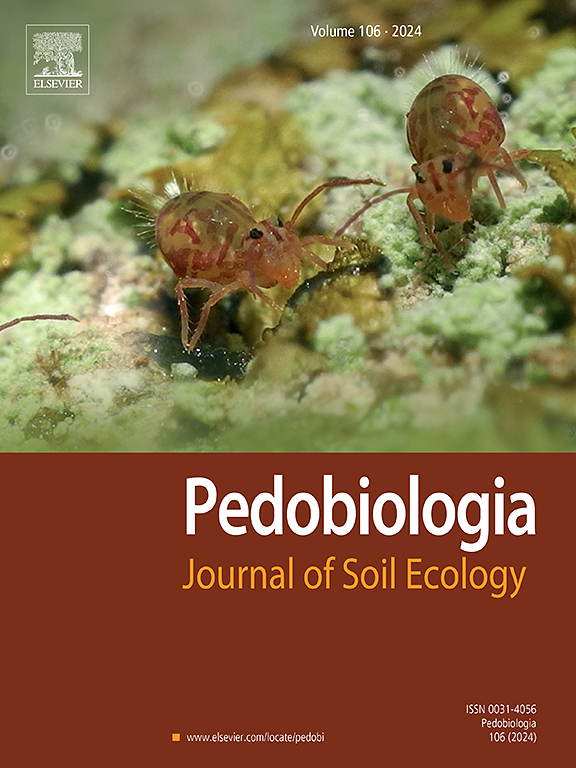坑式捕捉器保存液的吸引力使啮齿目动物密度的估算变得复杂
IF 2.2
3区 农林科学
Q3 ECOLOGY
引用次数: 0
摘要
鞘尾类群落由三种生态形态定义的生命形式组成:雌鞘类生活在土壤基质中,雄鞘类(包括大气生物)生活在地面和植被中,而半鞘类则处于中间状态。绝大多数的春尾草群落研究都集中在地下(雌雄同体和半雌雄同体),一般通过采集和提取土芯来收集。很少有研究涉及到通常使用坑式陷阱捕获的表生鞘翅目昆虫,迄今为止只有极少数研究涵盖了所有三种生命形式。当同时使用两种方法对表生和地下物种进行取样时,岩心数据(真实密度,[个体 m-2])和坑阱数据(活动丰度,[个体陷阱-1 陷坑期长度-1])可以独立分析,但在一个共同的统计框架中却互不兼容。作为一种补救措施,文献中描述了两种从活动丰度估算真实密度的相互竞争的数值方法:嵌套交叉阵列法和双圆法。捕集器保存液的吸引或威慑效应会使嵌套交叉阵列法的密度估算产生偏差,但不会使双圆法的密度估算产生偏差。为了确定这种偏差是否会对褶虫造成影响,从而确定在未来的研究中应采用哪种方法,我们通过实验测试了防腐液对诱捕器捕获率的潜在影响。三种保存液(苯甲酸钠、丙二醇、甲醛)和一种洗涤剂(吐温80)显著增加了捕获的鞘尾数量,从而证明了吸引效应和嵌套交叉阵列的不足。因此,在今后的鞘翅目群落研究中,我们建议在传统的重点研究雌雄同体生物的基础上,利用陷阱对雌雄同体物种进行取样,然后用双圈法重新修改诱捕数据。本文章由计算机程序翻译,如有差异,请以英文原文为准。
Attraction of pitfall trap preservation fluids complicates the estimation of Collembola density
Collembola (springtail) communities consist of three eco-morphologically defined life forms: the euedaphics dwell inside the soil matrix, the epedaphics (including atmobiotics) live on the ground and in vegetation, and the hemiedaphics are intermediate. The vast majority of springtail community studies focus on the belowground (eu- and hemiedaphic) forms that are generally collected by taking and extracting soil cores. Few investigations have dealt with epedaphic Collembola that are usually captured with pitfall traps, and only very few studies so far covered all three life forms. When epedaphic and belowground species are sampled using both methods simultaneously, core data (true densities, [individuals m−2]) and pitfall data (activity abundances, [individuals trap−1 length of trapping period−1]) may be analyzed independently, but are incompatible in a common statistical framework. As a remedy, two competing numerical approaches to estimate true densities from activity abundances have been described in literature: the nested-cross array and the two-circle method. Attraction or deterrence effects of trap preservation fluids bias the density estimation of the nested-cross array, but not of the two-circle method. To determine whether this bias may be expected for Collembola, and thus which of the two methods should be used in future studies, we experimentally tested potential effects of preservation fluids on trap catch rates. Three preservation fluids (sodium benzoate, propylene glycol, formaldehyde) and a detergent (Tween80) significantly increased the number of captured springtails, thus demonstrating an attraction effect and the deficiency of the nested-cross array. In future studies of collembolan communities, we therefore suggest complementing the traditional focus on the eu- and hemiedaphic life forms by sampling epedaphic species using pitfalls, and subsequently remodelling the trapping data with the two-circle method.
求助全文
通过发布文献求助,成功后即可免费获取论文全文。
去求助
来源期刊

Pedobiologia
环境科学-生态学
CiteScore
4.20
自引率
8.70%
发文量
38
审稿时长
64 days
期刊介绍:
Pedobiologia publishes peer reviewed articles describing original work in the field of soil ecology, which includes the study of soil organisms and their interactions with factors in their biotic and abiotic environments.
Analysis of biological structures, interactions, functions, and processes in soil is fundamental for understanding the dynamical nature of terrestrial ecosystems, a prerequisite for appropriate soil management. The scope of this journal consists of fundamental and applied aspects of soil ecology; key focal points include interactions among organisms in soil, organismal controls on soil processes, causes and consequences of soil biodiversity, and aboveground-belowground interactions.
We publish:
original research that tests clearly defined hypotheses addressing topics of current interest in soil ecology (including studies demonstrating nonsignificant effects);
descriptions of novel methodological approaches, or evaluations of current approaches, that address a clear need in soil ecology research;
innovative syntheses of the soil ecology literature, including metaanalyses, topical in depth reviews and short opinion/perspective pieces, and descriptions of original conceptual frameworks; and
short notes reporting novel observations of ecological significance.
 求助内容:
求助内容: 应助结果提醒方式:
应助结果提醒方式:


